Eggs 101
Federal and provincial laws allow farmers to work together to match what they produce with what consumers need and want. This management process results in a stable supply of food without creating excess surpluses.
Egg Nutrition
Eggs: Full of What Your Body Needs
Eggs are an excellent source of high quality protein plus they provide many vitamins and minerals, including vitamin B12, riboflavin, vitamin D, folate and choline. Eggs are one of nature’s most nutrient-dense foods.
Vitamin A
Helps maintain healthy skin and eye tissue; assists in night vision.
Vitamin D
Strengthens bones and teeth; may help protect against certain cancers and autoimmune diseases.
Vitamin E
An antioxidant that plays a role in maintaining good health and preventing disease.
Vitamin B12
Helps protect against heart disease.
Folate
Helps produce and maintain new cells; helps prevent a type of anemia; helps protect against serious birth defects if taken prior to pregnancy and during the first 3 months of pregnancy.
Protein
Essential for building and repairing muscles, organs, skin, hair and other body tissues; needed to produce hormones, enzymes and antibodies; the protein in eggs is easily absorbed by the body.
Selenium
Works with vitamin E to act as an antioxidant to help prevent the breakdown of body tissues.
Lutein and zeaxanthin
Maintains good vision; may help reduce the risk of age-related eye diseases such as cataracts and macular degeneration.
Choline
Plays a strong role in brain development and function.
Iron
Carries oxygen to the cells, helps prevent anemia.
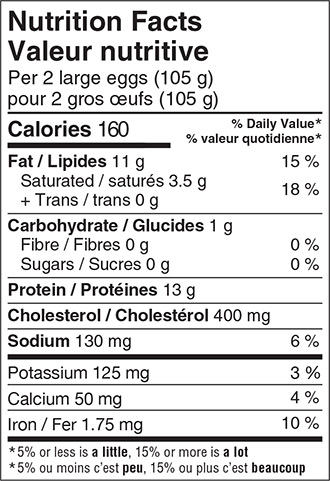
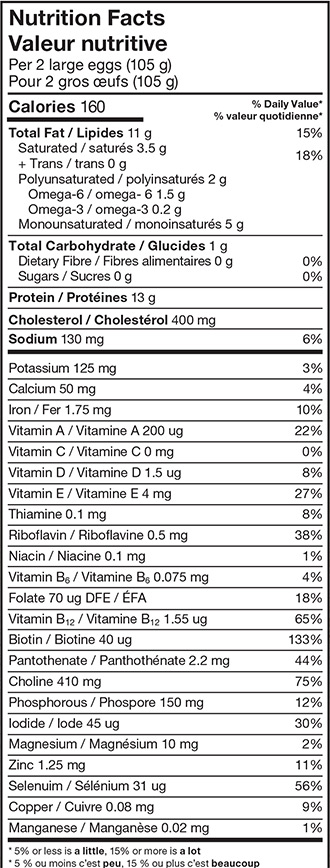
The Importance of Protein
A number of bodily functions are dependent on the presence of protein in the diet, or more specifically, amino acids. Our bodies digest dietary proteins and break them down to amino acids, which are then shipped off to different parts of the body.
Eggs are considered a ‘complete protein’ as they contain all nine essential amino acids along with a wide array of other vitamins and minerals. The natural protein from an egg is best-absorbed and utilized by the body, and therefore egg protein is considered to be the gold standard of protein quality. All other protein sources are measured with respect to the egg.
Protein is an important part of every cell in the body, it is needed to:
- build and repair body tissue
- help fight infections
- help keep body fluids in balance
- serve as enzymes and hormones
- help the body maintain a healthy metabolism
supply energy (calories) so the body can function
Did You Know…
Egg whites contain only half of the egg’s protein, so it is important to eat the whole egg to fully enjoy its energy boosting potential.
Egg Protein Can Help You Lose Weight
In a recent study, an egg-based breakfast was compared to a bagel-based breakfast containing the same number of calories. Researchers found those who ate two eggs and toast for breakfast lost 65% more weight, had an 83% greater reduction in waist circumference and experienced higher energy levels than those who ate a bagel and yogurt for breakfast.
Biological Value of Egg Protein
Eggs have the highest biological value of any food protein, which means the amino acids found in eggs are converted into body tissue more efficiently than any other known dietary protein. Egg protein (along with milk and soy protein) possesses the highest possible Protein Digestibility Corrected Amino Acid Score (PDCAAS), the most commonly used measure of protein quality. One large egg contains about 6 grams of high-quality protein, which makes it an ideally-packaged amino acid component for refueling after exercise.
Care & Quality
Manitoba Egg Farmers and the Canadian Food Inspection Agency (CFIA) work cooperatively to ensure Canadians can have confidence in the safety and quality of Grade A eggs.
Egg Farmers
Canadian farmers have been leaders in the development of on-farm HACCP standards for egg production. HACCP stands for Hazard Analysis & Critical Control Points and is the internationally accepted method for enhancing food safety. HACCP principles have been incorporated into an on-farm food safety and biosecurity program called Start Clean-Stay Clean™ to which Manitoba farmers adhere.
Graders
Eggs travel from the farm to the grading station and then to the grocer’s cooler, all within a week. At the grading station, eggs are washed in a high-speed tunnel washer. Then the eggs pass over a strong light called candling, to remove any cracks or imperfections. Eggs that do not meet high standards are not classified as Grade A. Canada Grade A eggs must have a thick white (albumen) and well-centered yolk, a very small air cell and a clean, uncracked shell.
Processors
Regulated egg farmers in Manitoba produce about 69 million dozen eggs each year. About 55% of these eggs are sold to retailers and the restaurants. The remaining 45% of all grades and sizes are processed into liquid, frozen or dried form. Manitoba is home to one of the largest processors in Canada – Burnbrae Farms Ltd.
At the processing plant, special machines break thousands of eggs per day. The yolks and whites may be pasteurized and processed or special components extracted. These products are sold around the world. The shells can be recycled and used as a source of calcium. Processed eggs are used in the foodservice industry and as an important ingredient in many foods, including mayonnaise, noodles and baked goods. They are also used in pharmaceuticals, shampoo, pet foods and adhesives.
Making the Grade
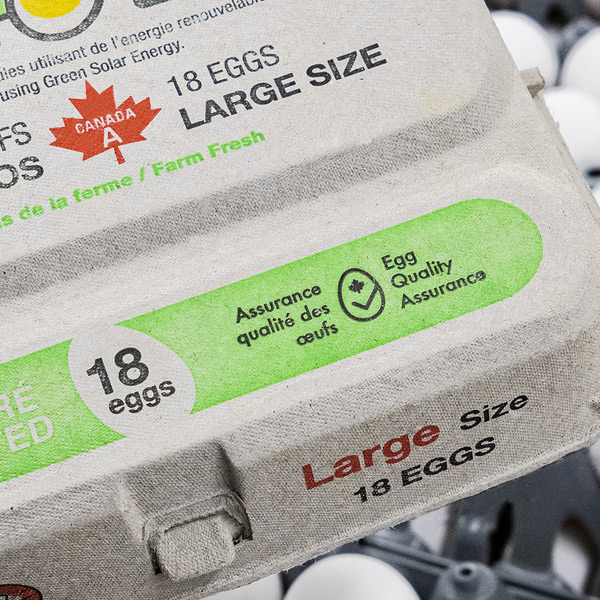
Agriculture and Agri-Food Canada regulations define three quality grades that apply to eggs for sale to customers. These are:
- Grade A – sold at grocery stores
- Grade B – used mostly in bakeries
- Grade C – processed into pasteurized product
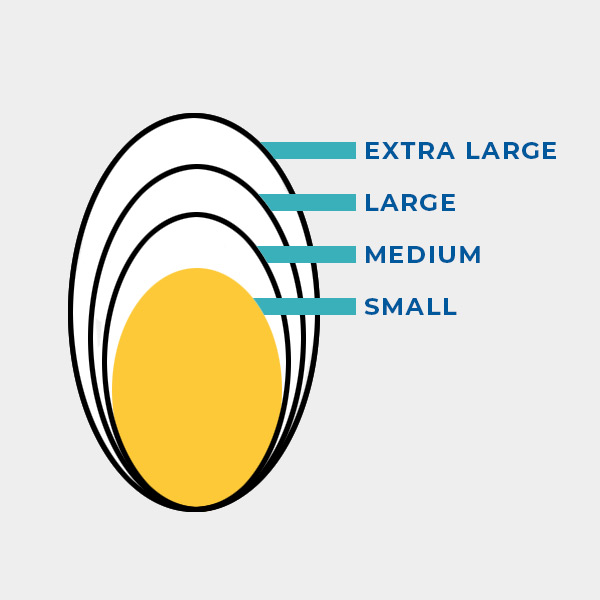
Only Grade A eggs are sized according to the weight of each egg:
- Jumbo – at least 70 g
- Extra Large – at least 63 g
- Large – at least 56 g
- Medium – at least 49 g
- Small – at least 42 g
- Pee Wee – less than 42 g
Canadian Food Inspection Agency (CFIA) inspectors monitor graded eggs to make sure they pass rigid standards.
Blood Spots
Blood spots are occasionally found on an egg yolk. These tiny spots are not harmful and are accidentally caused by blood or tissue rupture during formation of the egg. Less than 1% of eggs produced have blood spots.
Mass candling methods reveal most blood spots, and those eggs are removed, but, even with electronic spotters, it is impossible to catch all of them. If desired, the spot can be removed with the tip of a clean knife prior to cooking.
Yolk Colour
This is determined by the diet of the hen and does not affect the taste, nutritive value or quality of the egg. Hens fed a larger portion of wheat in relation to other components of the diet produce eggs with pale yolks. A diet containing a high proportion of yellow corn, for example, will result in eggs with much darker yolks. The choice of grains depend primarily on the availability of these crops.
Shell Colour
May vary from white to brown, depending upon the strain of the hen. There is no difference in taste or nutritive value between a brown-shelled and white-shelled egg.
Egg White Colour
Sometimes the egg white may have a greenish colour due to the presence of riboflavin (vitamin B12). Carbon dioxide in a very fresh egg may cause the white to be cloudy. In both cases, the egg is perfectly wholesome.
Types of Eggs
Omega-3 Eggs
Omega-3 eggs are from hens fed a diet that contains 10 to 20 percent flaxseed. Flax contains omega-3 polyunsaturated fatty acids which are important for lowering blood triglyceride levels and have been associated with a reduced risk of heart disease.
Health Canada’s Nutrition Recommendations for Canadians suggest a daily intake of 1 to 1.5 g omega-3 fatty acids. Only a limited number of foods are rich in Omega-3 fats (fish, fish oils, canola oil, soybeans, flaxseed and some nuts). Enriching eggs with omega-3 provides another dietary source of this nutrient. Omega-3 eggs contain 0.4 g omega-3 fatty acids compared to 0.04 g omega-3 fatty acids in regular eggs. Omega-3 eggs can also contain up to eight times more vitamin E than regular eggs.
Why is there interest in Omega-3 Fatty Acids?
It has been known for many years that polyunsaturated fatty acids play a role in reducing the risk of heart disease. Current research findings suggest that omega-3 fatty acids help lower blood triglyceride levels. Omega-3 fatty acids are also required for normal growth and development and good vision.
The omega-3 egg can provide approximately 1/4 to 1/3 of the recommended daily intake of omega-3 fatty acids. The omega-3 enriched egg provides a dietary alternative to fish for these essential fatty acids. They offer the consumer greater choice.
What are Omega-3 Fatty Acids?
Omega-3 fatty acids are one type of polyunsaturated fatty acid. A second type are called omega-6. Monounsaturated fatty acids are from the omega-9 family of fatty acids. Only omega-9 fatty acids can be synthesized by our bodies. We must obtain omega-3 and omega-6 fatty acids from the foods we eat.
Which came first… the chicken or the egg?
In this case it was the chicken! Omega-3 enriched eggs are produced by altering the diet of laying hens. Hens are fed a special diet which contains 10-20% ground flaxseed. Flaxseed is higher in omega-3 fatty acids and lower in saturated fatty acids than other grains. As a result, the eggs produced from hens on this feed formula are higher in omega-3 fatty acids. The total fat content of the egg and the cholesterol level remains very similar.
Vitamin-Enhanced Eggs
Vitamin-enhanced eggs are from hens fed a nutritionally-enhanced diet containing higher levels of certain nutrients (e.g., vitamin E, folate, vitamin B6 and vitamin B12).
As a result, the eggs produced will contain higher levels of these nutrients.
Organic Eggs
Organic eggs are produced by hens fed certified organic feeds. Organic eggs have the same nutritional content as regular eggs, but have been raised in a free-run/range housing environment. Check for a “certified organic” designation on the carton plus the name of the certifying organization.
Vegetarian Eggs
Vegetarian eggs come from hens fed a diet containing only ingredients of plant origin.
Free-Run Eggs
Free-run housing gives hens access to the entire barn floor area. Hens are able to perch, scratch and lay their eggs in nesting boxes.
Free-Range Eggs
Free-range gives hens access to the outdoors and outdoor vegetation; weather permitting. Hens are able to perch, nest, dust bathe, scratch and forage.
Due to the extremes in our climate, outdoor access is only seasonally available in Canada.
Processed Eggs
Processed eggs are shell eggs broken by special machines then pasteurized before being further processed and packaged in liquid, frozen or dried form. Though some products are available at grocery stores, many processed egg products are used by the foodservice and food manufacturing industries.

 Affordable Meals
Affordable Meals New Recipes
New Recipes Powered by Eggs
Powered by Eggs Ho Ho Holidays!
Ho Ho Holidays! Recipe Booklets
Recipe Booklets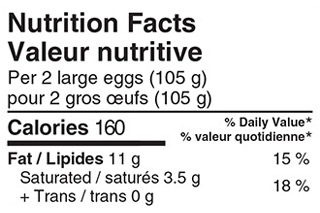 Egg Nutrition
Egg Nutrition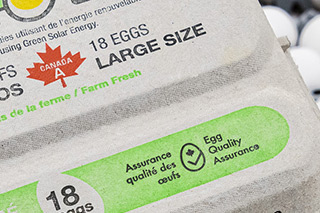 Care & Quality
Care & Quality Types of Eggs
Types of Eggs